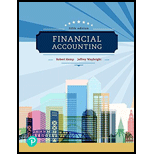
Financial Accounting
5th Edition
ISBN: 9780134728643
Author: Robert Kemp; Jeffrey Waybright
Publisher: Pearson Education (US)
expand_more
expand_more
format_list_bulleted
Concept explainers
Question
Chapter 1, Problem 32AP
1.
To determine
Analyze the transactions using the
2.
To determine
Prepare the income statement of Incorporation ID for the month ended April 30, 2018.
3.
To determine
Prepare the statement of
4.
To determine
Prepare the
Expert Solution & Answer
Want to see the full answer?
Check out a sample textbook solution
Students have asked these similar questions
A company purchased land for $92,000 cash. The real estate brokers' commission was $7,500 and $8,000 was spent for demolishing an old building on the land before construction of a new building could start. Proceeds from the salvage of the demolished building were $1,500. Under the cost principle, what would the cost of the land be recorded as?
What is the correct answer with financial accounting question
can you explain the steps for solving this General accounting question accurately?
Chapter 1 Solutions
Financial Accounting
Ch. 1 - The text states that accounting is the "language...Ch. 1 - Would you describe accounting as primarily a...Ch. 1 - Prob. 3DQCh. 1 - What are some reasons why accounting has adopted...Ch. 1 - What are some of the uses of financial statements?Ch. 1 - Prob. 6DQCh. 1 - Prob. 7DQCh. 1 - How is the accounting equation affected by each of...Ch. 1 - In what order should the financial statements be...Ch. 1 - Which financial statement would be most useful to...
Ch. 1 - Prob. 1SCCh. 1 - Prob. 2SCCh. 1 - Which accounting principle specifically states...Ch. 1 - Wave Rider is famous for custom skateboards. At...Ch. 1 - Assume that Wave Rider sold skateboards to a...Ch. 1 - Assume that Wave Rider sold skateboards to another...Ch. 1 - Assume that Wave Rider paid expenses totaling...Ch. 1 - Consider the overall effects of the transactions...Ch. 1 - The balance sheet reports a. a businesss financial...Ch. 1 - The income statement reports a. a business's...Ch. 1 - Prob. 11SCCh. 1 - Prob. 12SCCh. 1 - Accounting principles (Learning Objective 4) 5-10...Ch. 1 - Accounting principles (Learning Objective 4) 5-10...Ch. 1 - Prob. 3SECh. 1 - Basic accounting equation (Learning Objective 5)...Ch. 1 - Prob. 5SECh. 1 - Prob. 6SECh. 1 - Prob. 7SECh. 1 - Entering transactions in the accounting equation...Ch. 1 - Prob. 9SECh. 1 - Prob. 10SECh. 1 - Entering transactions in the accounting equation...Ch. 1 - Transaction analysis (Learning Objective 5) 5-10...Ch. 1 - Transaction analysis (Learning Objective 5) 5-10...Ch. 1 - Prob. 14SECh. 1 - Basic accounting equation (Learning Objective 5)...Ch. 1 - Basic accounting equation (Learning Objective 5)...Ch. 1 - Prob. 17AECh. 1 - Using the accounting equation to determine net...Ch. 1 - Transaction analysis (Learning Objective 5) 15-20...Ch. 1 - Types of business organizations and balance sheet...Ch. 1 - Types of accounts and income statement preparation...Ch. 1 - Using the accounting equation to determine net...Ch. 1 - Basic accounting equation (Learning Objective 5)...Ch. 1 - Prob. 24BECh. 1 - Prob. 25BECh. 1 - Prob. 26BECh. 1 - Transaction analysis (Learning Objective 5) 15-20...Ch. 1 - Prob. 28BECh. 1 - Prob. 29BECh. 1 - Prob. 30BECh. 1 - Transaction analysis and the calculation of net...Ch. 1 - Prob. 32APCh. 1 - A Preparing the income statement, statement of...Ch. 1 - Preparing the income statement and balance sheet;...Ch. 1 - Prob. 35APCh. 1 - Transaction analysis and the calculation of net...Ch. 1 - Prob. 37BPCh. 1 - Prob. 38BPCh. 1 - Preparing the income statement and balance sheet;...Ch. 1 - Prob. 40BPCh. 1 - Prob. 1CECh. 1 - This problem is the first problem in a sequence...Ch. 1 - Prob. 1CFSAPCh. 1 - Prob. 1EIACh. 1 - Prob. 2EIACh. 1 - Prob. 1FACh. 1 - Industry Analysis Purpose: To help you understand...Ch. 1 - Prob. 1SBACh. 1 - Prob. 1WC
Knowledge Booster
Learn more about
Need a deep-dive on the concept behind this application? Look no further. Learn more about this topic, accounting and related others by exploring similar questions and additional content below.Similar questions
- Accurate answerarrow_forwardPlease explain this financial accounting problem with accurate financial standards.arrow_forwardAt the beginning of the recent period there were 1,020 units of product in a department, one-third completed. These units were finished and an additional 5,500 units were started and completed during the period. 840 units were still in process at the end of the period. One-fourth completed. Using the weighted-average valuation method the equivalent units produced by the department were: A. 6,730 units B. 6,680 units C. 7,360 units D. 6,390 Units E. 8,250 unitsarrow_forward
- What is the value of inventory listed on the firm's balance sheet?arrow_forwardI am looking for help with this general accounting question using proper accounting standards.arrow_forwardI need help finding the accurate solution to this financial accounting problem with valid procedures.arrow_forward
- How much gross profit was realised from this sale ?arrow_forwardMCQarrow_forwardA manufacturing company applies overhead based on direct labor hours. At the beginning of the year, it was estimated that overhead costs would be $460,000 and direct labor hours would be 91,000. Actual overhead costs incurred were $458,000 and actual direct labor hours were 96,000. What is the amount of overapplied or underapplied overhead at the end of the year? A. $16,000 overapplied B. $16,000 underapplied C. $26,800 overapplied D. $9,000 underappliedarrow_forward
arrow_back_ios
SEE MORE QUESTIONS
arrow_forward_ios
Recommended textbooks for you


The accounting cycle; Author: Alanis Business academy;https://www.youtube.com/watch?v=XTspj8CtzPk;License: Standard YouTube License, CC-BY